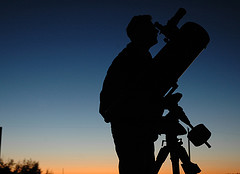October 7th, 2009 by Eugene Barsky | No Comments »

A new article today in the Journal of the American Society for Information Science could be of interest to those of you who post their studies to arxiv.org:
A. Haque and P. Ginsparg, “Positional effects on citation and readership in arXiv,” J. Am. Soc. Inf. Sci. Technol., vol. 60, pp. 2203-2218, 2009.
Abstract:
arXiv.org mediates contact with the literature for entire scholarly communities, providing both archival access and daily email and web announcements of new materials. We confirm and extend a surprising correlation between article position in these initial announcements and later citation impact, due primarily to intentional  self-promotion
self-promotion by authors. There is, however, also a pure
by authors. There is, however, also a pure  visibility
visibility effect: the subset of articles accidentally in early positions fared measurably better in the long-term citation record. Articles in astrophysics (astro-ph) and two large subcommunities of theoretical high energy physics (hep-th and hep-ph) announced in position 1, for example, respectively received median numbers of citations 83%, 50%, and 100% higher than those lower down, while the subsets there accidentally had 44%, 38%, and 71% visibility boosts. We also consider the positional effects on early readership. The median numbers of early full text downloads for astro-ph, hep-th, and hep-ph articles announced in position 1 were 82%, 61%, and 58% higher than for lower positions, respectively, and those there accidentally had medians visibility-boosted by 53%, 44%, and 46%. Finally, we correlate a variety of readership features with long-term citations, using machine learning methods, and conclude with some observations on impact metrics and the dangers of recommender mechanisms.
effect: the subset of articles accidentally in early positions fared measurably better in the long-term citation record. Articles in astrophysics (astro-ph) and two large subcommunities of theoretical high energy physics (hep-th and hep-ph) announced in position 1, for example, respectively received median numbers of citations 83%, 50%, and 100% higher than those lower down, while the subsets there accidentally had 44%, 38%, and 71% visibility boosts. We also consider the positional effects on early readership. The median numbers of early full text downloads for astro-ph, hep-th, and hep-ph articles announced in position 1 were 82%, 61%, and 58% higher than for lower positions, respectively, and those there accidentally had medians visibility-boosted by 53%, 44%, and 46%. Finally, we correlate a variety of readership features with long-term citations, using machine learning methods, and conclude with some observations on impact metrics and the dangers of recommender mechanisms.
** Photo by http://www.flickr.com/photos/easternblot/ – “Paul Ginsparg shows that everyone submits their paper to ArXiv *just* after the submission deadline so they’ll be the first on the front page the next day”
Posted in Astronomy, Atmospheric Science, Chemical and Biological Engineering, Chemistry, Civil Engineering, Earth and Ocean Sciences, General Science, Geography, Main, Materials Engineering, Mathematics, Mechanical Engineering, Mining engineering, Physics, Science - undegraduate classes, Statistics, Uncategorized | No Comments »
October 1st, 2009 by Eugene Barsky | No Comments »
Those of us, who teach or use Google or Google Scholar (GS) might find the most recent Peter Jacso’s piece on Google Scholar to be of interest – http://www.libraryjournal.com/article/CA6698580.html?&rid=1105906703&source=title
Please be very careful using this tool. We talk about the perils of GS and compare it with Compendex and Web of Science in our Google workshops.
We ourselves saw those problems almost five years ago, and they are still not corrected:
Giustini D, & Barsky E. A look at Google Scholar, PubMed and Scirus: comparisons and recommendations . J Can Health Libr Assoc 2005, 26(3): 85-89.
Posted in Astronomy, Atmospheric Science, Chemical and Biological Engineering, Chemistry, Civil Engineering, Earth and Ocean Sciences, General Science, Geography, Main, Materials Engineering, Mathematics, Mechanical Engineering, Mining engineering, Physics, Science - undegraduate classes, Statistics, Teaching, Wood Sciences | No Comments »
July 24th, 2009 by Kevin Lindstrom | No Comments »
The Niels Bohr Library and Archives of the American Institute of Physics holds more than a thousand tape-recorded interviews. Many of the oral history interview transcripts are now online. The interviews, conducted by the staff of the AIP Center for History of Physics and many other historians, offer unique insights into the lives, works, and personalities of modern scientists.
For more information, go to Niels Bohr Library & Archives
Submitted by Kevin Lindstrom Liaison Librarian for Physics and Astronomy at the University of British Columbia.
Posted in Astronomy, General Science, Physics, Podcasts | No Comments »
July 3rd, 2009 by Eugene Barsky | No Comments »

A very recent article on PLoS One is worth the read –
Bollen J, Van de Sompel H, Hagberg A, Chute R, 2009 A Principal Component Analysis of 39 Scientific Impact Measures. PLoS ONE 4(6): e6022. doi:10.1371/journal.pone.0006022
Abstract:
Background
The impact of scientific publications has traditionally been expressed in terms of citation counts. However, scientific activity has moved online over the past decade. To better capture scientific impact in the digital era, a variety of new impact measures has been proposed on the basis of social network analysis and usage log data. Here we investigate how these new measures relate to each other, and how accurately and completely they express scientific impact.
Methodology
We performed a principal component analysis of the rankings produced by 39 existing and proposed measures of scholarly impact that were calculated on the basis of both citation and usage log data.
Conclusions
Our results indicate that the notion of scientific impact is a multi-dimensional construct that can not be adequately measured by any single indicator, although some measures are more suitable than others. The commonly used citation Impact Factor is not positioned at the core of this construct, but at its periphery, and should thus be used with caution.
Frankly, I was surprised by the authors’ conclusion, particularly with this piece: “Our results indicate that the JIF and SJR express a rather particular aspect of scientific impact that may not be at the core of the notion of scientific “impact”. Usage-based measures such as Usage Closeness centrality may in fact be better “consensus” measures.”
I am used to be inquired about Journal Impact Factor (JIF) so often in academia and know that it used for tenure consideration in many departments in UBC.
** photo by testone 22
Posted in Astronomy, Atmospheric Science, Chemical and Biological Engineering, Chemistry, Civil Engineering, Earth and Ocean Sciences, General Science, Geography, Main, Materials Engineering, Mathematics, Mechanical Engineering, Physics, Podcasts, Science - undegraduate classes, Statistics, Wood Sciences | No Comments »
June 9th, 2009 by Eugene Barsky | No Comments »

Thomson Reuters has released its latest figures for Canadian Science last week – http://sciencewatch.com/dr/sci/09/may31-09_2/
Between 2004 and 2008, Thomson Reuters indexed 226,232 papers that listed at least one author address in Canada. Of those papers, the highest percentage appeared in journals classified under the heading of environment/ecology, followed by psychiatry/psychology and geosciences. As the right-hand column shows, the citations-per-paper average for environment/ecology papers from Canada-based authors was 24% above the world average in the field (5.49 cites per paper for Canada versus 4.43 cites for the world). In fact, in all the fields shown here, the impact of Canadian research exceeded the world average, with particularly strong performance in space science (44% above the world average), physics (43% above), and agricultural sciences (+29%).
It is great to see that we are producing a decent share of world’s research. But it seems that Engineering is one of weak points!
** Photo by tripleman
Posted in Astronomy, Atmospheric Science, Chemical and Biological Engineering, Chemistry, Civil Engineering, Earth and Ocean Sciences, General Science, Geography, Main, Materials Engineering, Mathematics, Mechanical Engineering, News, Physics, Science - undegraduate classes, Statistics, Wood Sciences | No Comments »
May 29th, 2009 by Kevin Lindstrom | No Comments »
The following presentations including audio and visual when available are now online from cIRcle, the UBC Library’s digital repository.
- Building an organization that can build a quantum computer Rose, Geordie
- The Dark Side of the Universe Van Waerbeke, Ludovic
- Frontiers in Nuclear Theory: From Light Nuclei to Astrophysics Bacca, Sonia
- Identifying, measuring, and teaching physics expertise Wieman, Carl
- Snowflakes, Stress and Semiconductors: Do You See a Pattern Here? Taylor, Richard
Submitted by Kevin Lindstrom Liaison Librarian for Physics and Astronomy
Posted in Astronomy, General Science, Physics, Podcasts | No Comments »
May 21st, 2009 by Eugene Barsky | No Comments »

In celebration of the International Year of Astronomy in 2009, New Scientist takes you on an armchair tour of some of the most important telescopes ever built – http://www.newscientist.com/gallery/dn16663-important-telescopes
UBC Library owns dozens of books on telescopes. See some of them here- Telescopes.
** Photo by Space Ritual
Posted in Astronomy, Atmospheric Science, Earth and Ocean Sciences, General Science, Geography, Main, Physics | No Comments »
May 15th, 2009 by Kevin Lindstrom | No Comments »
The 11th Annual Meeting has come to Vancouver. Running from May 14 – May 16th, this annual meeting attracts physicists from the Pacific Northwest including Alberta.
Topics range from Finding and Characterizing Extrasolar Planets to relativistic non-instantaneous action-at-a-distance interactions.
For more information, go to the APS Northwest Chapter website.
Friday’s morning Welcome and Plenary Session were recorded and will be available online shortly from cIRcle
Submitted by Kevin Lindstrom Liaison Librarian for Physics and Astronomy
Posted in Astronomy, Physics | No Comments »
self-promotion
by authors. There is, however, also a pure
visibility
effect: the subset of articles accidentally in early positions fared measurably better in the long-term citation record. Articles in astrophysics (astro-ph) and two large subcommunities of theoretical high energy physics (hep-th and hep-ph) announced in position 1, for example, respectively received median numbers of citations 83%, 50%, and 100% higher than those lower down, while the subsets there accidentally had 44%, 38%, and 71% visibility boosts. We also consider the positional effects on early readership. The median numbers of early full text downloads for astro-ph, hep-th, and hep-ph articles announced in position 1 were 82%, 61%, and 58% higher than for lower positions, respectively, and those there accidentally had medians visibility-boosted by 53%, 44%, and 46%. Finally, we correlate a variety of readership features with long-term citations, using machine learning methods, and conclude with some observations on impact metrics and the dangers of recommender mechanisms.




